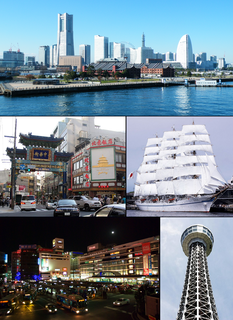
Small hydro is the development of hydroelectric power on a scale suitable for local community and industry, or to contribute to distributed generation in a regional electricity grid. The definition of a small hydro project varies, but a generating capacity of 1 to 20 megawatts (MW) is common. In contrast many hydroelectric projects are of enormous size, such as the generating plant at the Three Gorges Dam at 22,500 megawatts or the vast multiple projects of the Tennessee Valley Authority. In India, hydro projects up to 25 MW station capacities have been categorized as Small Hydro Power (SHP) projects.

Hydroelectricity is electricity produced from hydropower. In 2015, hydropower generated 16.6% of the world's total electricity and 70% of all renewable electricity, and was expected to increase about 3.1% each year for the next 25 years.

Sagamihara is a city in Kanagawa Prefecture, Japan. It is the third most populous city in the prefecture, after Yokohama and Kawasaki, and the fifth most populous suburb of the Greater Tokyo Area. Its northern neighbor is Machida, with which a cross-prefectural merger has been proposed.

The Tokuyama Dam is an embankment dam near Ibigawa, Ibi District, Gifu Prefecture in Japan. The dam was completed in 2008 and will support a 153 MW hydroelectric power station that is expected to be fully operational in 2015. Currently, Unit 1 at 23 MW was commissioned in May 2014. The dam was originally intended to withhold the upper reservoir of a 400 MW pumped-storage power station until a design change in 2004. The dam is also intended for flood control and water supply. It is the largest dam by structural volume in Japan and withholds the country's largest reservoir by volume as well.

Fujiwara Dam (藤原ダム) is a gravity dam on a Tone River tributary in Gunma Prefecture of Japan. It is located 14 km (9 mi) north of Minakami. It was constructed between 1951 and 1957. The dam itself supports a single Francis turbine hydroelectric generator with a 23 MW capacity which was commissioned in 1957. The reservoir created by the dam serves as the lower reservoir for the 1,200 Tamahara Pumped Storage Power Station which was commissioned in 1986. The dam is 95 m (312 ft) high and withholds a reservoir with a 52,490,000 m3 (42,554 acre⋅ft) storage capacity.
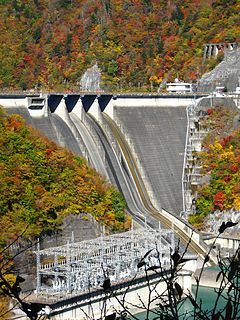
The Hatanagi-I is a dam on the Ōi River in Aoi-ku, Shizuoka, Shizuoka Prefecture on the island of Honshū, Japan. With a height of 125 metres (410 ft), it is the tallest hollow-core concrete gravity dam in the world. It has a hydroelectric power generating station owned by the Chubu Electric Power Company. It supports a 137 megawatts (184,000 hp) pumped-storage hydroelectric power station.

The Hatanagi-II is a dam on the Ōi River in Aoi-ku, Shizuoka, Shizuoka Prefecture on the island of Honshū, Japan. A hollow-core concrete gravity dam, it has a hydroelectric power generating station owned by the Chubu Electric Power Company.
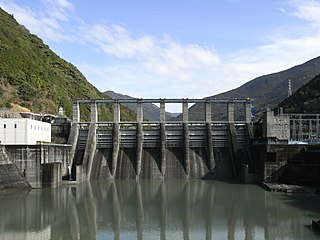
The Akiba Dam is a dam on the Tenryū River, located in Tenryū-ku, Hamamatsu, Shizuoka Prefecture on the island of Honshū, Japan.

The Miyagase Dam is a dam on the Nakatsu River, a main tributary of the Sagami River in Aikō District, Kanagawa Prefecture, Japan. It straddles the border between the village of Kiyokawa, town of Aikawa and the former town of Tsukui.

The Miho Dam is a multi-purpose dam on the Kawauchi River, a tributary stream of the Sakawa River in the town of Yamakita, Ashigarakami District, Kanagawa Prefecture on the island of Honshū, Japan. The dam is located within the borders of the Tanzawa-Ōyama Quasi-National Park.
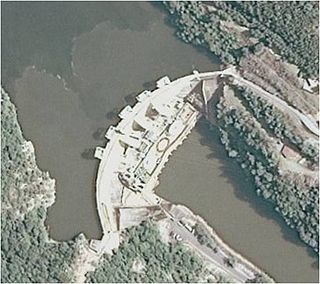
Smith Mountain Dam is a concrete arch dam located on the Roanoke River in Virginia, creating Smith Mountain Lake. The dam was built by Appalachian Power between 1960 and 1963 for the purposes of pumped-storage hydroelectricity. The dam created Smith Mountain Lake as its reservoir, where recreation and real estate have become popular.

The Kannagawa Hydropower Plant (神流川発電所) is an under construction pumped-storage hydroelectric power plant near Minamiaiki in Nagano Prefecture and Ueno in Gunma Prefecture, Japan. The power plant utilizes the Minamiaiki River along with an upper and lower reservoir created by two dams, the upper Minamiaiki Dam and the lower Ueno Dam. The power station in between the two dams will contain six 470 megawatts (630,000 hp) pump-generators for a total installed capacity of 2,820 megawatts (3,780,000 hp). Unit 1 commenced commercial operation in 2005 and Unit 2 in 2012. When completed, the plant will have the second-largest pumped-storage power capacity in the world.
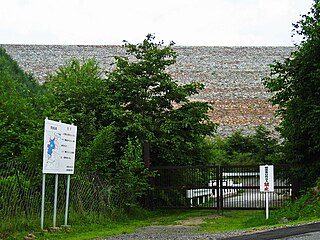
The Kazunogawa Pumped Storage Power Station is a pumped-storage hydroelectric power station near Kōshū in Yamanashi Prefecture, Japan. The station is designed to have an installed capacity of 1,600 megawatts (2,100,000 hp) and three of the four 400 megawatts (540,000 hp) generators are currently operational, for a total operational capacity of 1200 MW. Construction on the power station began in 1993 and the first generator was commissioned on 3 December 1999. The second was commissioned on 8 June 2000. The third on become operational on 9 June 2014, six year early due to post-power demand from the Great East Japan earthquake. The fourth and final generator is slate to be commissioned by 2024. It is owned by TEPCO and was constructed at a cost of $2.2 billion USD.
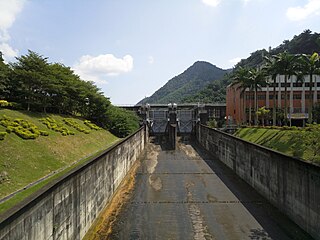
The Minghu Dam (Chinese: 明湖水庫; pinyin: Mínghú Shuǐkù, renamed the Takuan Dam, is a concrete gravity dam on the Shuili River located 7 km north of Shuili Township in Nantou County, Taiwan. The dam was constructed to serve as the lower reservoir for the Minhu Pumped Storage Hydro Power Station. Sun Moon Lake serves as the upper reservoir.

The Matanoagawa Dam (俣野川ダム) is a concrete gravity dam on a tributary of the Hino River located 2.3 km (1 mi) south of Kōfu in Tottori Prefecture, Japan. Construction on the dam began in 1978 and it was complete in 1984. The primary purpose of the dam is hydroelectric generation and it creates the lower reservoir for the Matanoagawa Pumped Storage Power Station (俣野川発電所). It is 69.3 metres (227 ft) tall and creates a reservoir with a 7,940,000-cubic-metre (6,440 acre⋅ft) storage capacity. The power station is located on the southern bank of the reservoir and contains four 300 megawatts (400,000 hp) Francis pump-turbine-generators. The upper reservoir for the pumped-storage scheme is created by the Doyo Dam located 6 kilometres (3.7 mi) to the southeast in Okayama Prefecture. To generate power, water from the Doyo Dam is sent to the power station, used to generate electricity and then discharged into the Matanoagawa Reservoir. This occurs when energy demand is high and when it is low, water is pumped back up to the Doyo Dam as stored energy. The same pump-generators that pump the water to Doyo reverse and generate electricity when it is sent back down. The first generator was operational in 1992 and the last in 1996.

The Okukiyotsu Pumped Storage Power Station No. 1 and No. 2 are two large pumped-storage hydroelectric power plants in Yuzawa, Minamiuonuma, Niigata Prefecture, Japan. With a combined installed capacity of 1,600 megawatts (2,100,000 hp), the system is the third largest pumped-storage power station in Japan.

The Shimogo Pumped Storage Power Station is a large pumped-storage hydroelectric power plant in Shimogō, Minamiaizu, Fukushima Prefecture, Japan. With an installed capacity of 1,000 megawatts (1,300,000 hp), the system is one of the largest pumped-storage power stations in Japan.

The Shintoyone Pumped Storage Power Station is a large pumped-storage hydroelectric power plant in Toyone, Kitashitara, Aichi Prefecture, Japan. With an installed capacity of 1,125 megawatts (1,509,000 hp), the plant is one of the largest pumped-storage power stations in Japan.




